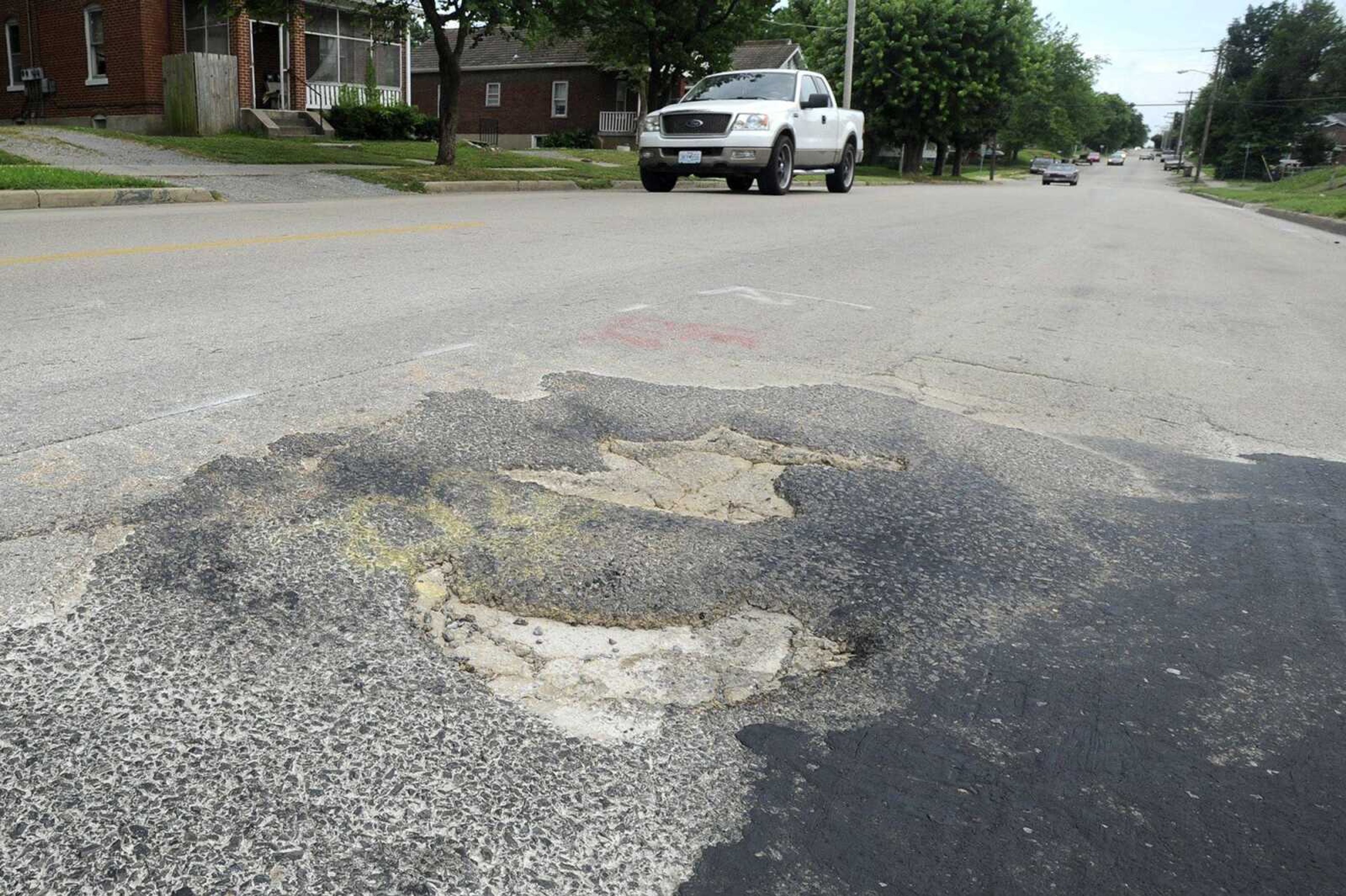Motorists traveling on many Cape Girardeau city streets experience a bumpy, bone-jarring ride over crumbling pavement that in many cases doesn’t meet current construction codes.
Some concrete streets have been patched over the years but continue to fall apart.
City council members have heard residents’ complaints.
City manager Scott Meyer said many of the concrete streets are at least 25 or 30 years old — the city’s website says the average age for a street is 35 years — and most of them were built on compacted dirt rather than a gravel base, which is standard construction practice today.
Meyer, a former state highway engineer, said when he was hired as city manager in 2009, the city allowed streets to be paved directly over compacted dirt.
“I don’t know why they made that choice,” he said.
Under Meyer, the city adopted new construction standards requiring developers and contractors to place a four-inch base of gravel over the dirt as a foundation for the pavement.
Stan Polivick, public works assistant director, said the change was made in 2010 in conjunction with a number of new development codes adopted by the city.
Meyer and Polivick said using a gravel base is standard practice elsewhere in road construction.
“It is an engineering principle,” said Meyer, who previously served as district engineer for the Missouri Department of Transportation in Sikeston, Missouri.
He said the highway department required such a base for construction of roads.
Polivick said it was standard practice to use a gravel base for road building in Southern states where he used to live.
Meyer said a gravel base helps with drainage.
“It helps keep moisture away from the concrete,” he said.
Public works crews routinely have patched and repaired streets over the years. But the growing age of the streets, aggravated by harsh winters and sizzling summers in recent years, has led to a growing number of roads that need their pavement replaced, city officials said.
Heat can cause roadways to buckle, Polivick said.
“Most of the roadways have gone past their design life,” he said.
Two-thirds of city streets are concrete pavement, with asphalt pavement accounting for the other third.
A concrete street is designed to last 25 years, and an asphalt road, 15 years, Polivick said, adding streets often can last much longer.
Meyer said a gravel base, such as what is being used now with street construction, should help extend the life of the pavement.
The city council pledged to use millions of dollars in Transportation Trust Fund money to address some of the cracked, crumbling sections of streets.
In August, voters approved a five-year extension of the half-cent sales tax (Transportation Trust Fund 5 or TTF 5) after city officials promised to fix city streets.
The city plans to spend nearly $8 million of TTF 5 money over the next five years to replace more than 100 segments of roadways, which includes paving some alleyways.
Some segments cover a block or two; others are shorter sections, officials said.
Most are in residential neighborhoods.
Polivick said the total includes $4.25 million to fix dilapidated concrete streets and $3.5 million to fix deteriorating asphalt roads.
But with the pay-as-you-go trust fund program, revenue from the latest tax extension won’t be used for street-replacement work until 2017, he said.
The city, however, already is proceeding with street repairs, thanks to money saved by not moving ahead with the Armstrong Drive extension project.
As a result, the city has $3.2 million available to spend this year and next year on replacing badly worn segments of concrete streets.
That money is in addition to TTF 5 money.
The city council earlier this year awarded a contract to Nip Kelley Equipment Co. to do the 2016 street work at a cost of $1.19 million.
Pavement replacement work is well underway in the Lexington Place neighborhood off Lexington Avenue and will be followed up by improvements in the Ashland Hills subdivision on the city’s west side — two of the areas with numerous rundown streets.
Sections of a dozen concrete streets will be fixed by the contractor, with the work scheduled to be finished by the end of the year.
Mayor Harry Rediger said he already has heard positive comments from Lexington Place residents about the work that has been completed.
The city is spending another $225,000 this year on a contract with ASA Asphalt of Advance, Missouri, to resurface pavement with hot-mix asphalt on sections of seven streets.
TTF 4 money is being used to pay for that project, officials said.
The city also has one four-man crew assigned full-time to street repairs, Polivick said.
A second four-man crew assists in making repairs as needed. The second crew at times does cold-mix patching of potholes.
The cost of city-crew repairs is paid from the operating budget. Polivick said city crews handle small street repairs.
“We won’t do a whole block,” he said.
The city used to operate an asphalt paving machine for overlay work. But the machine broke down a few years ago. Replacing it would cost about $300,000, Polivick said.
City staff have concluded such an expense is not warranted, he said.
Council members said they continue to receive complaints about the poor conditions of some city streets. One of those is Lexington Avenue, particularly the concrete pavement between Perryville Road and Cape Rock Drive.
“The long-term plan is to overlay all of Lexington,” Rediger said.
Meyer told the council earlier this year deteriorating roads will continue to pose a challenge.
“I think it is going to remain an issue for a while,” he said.
mbliss@semissourian.com
(573) 388-3641
---
Facts about streets
Cape Girardeau maintains:
* 233 miles of streets
* 22 miles of alleyways
* Two-thirds of city streets are paved in concrete; a third are asphalt
* Much of the pavement is at least 30 years old
Coming repairs
* In 2015, the city had nearly 32 million square feet of pavement
* About 25 percent needed some type of repair
* City plans to spend from Transportation Trust Fund 5 money over next five years:
* $4.25 million to fix concrete streets over next five years
* $3.5 million to fix asphalt streets over the next five years.
* That works out to $850,000 a year for major concrete repairs and $700,000 a year for major asphalt repairs.
* In addition, the city is spending $3.2 million on replacing dilapidated sections of concrete streets over a two-year period, which began this year from savings resulting from scrapping the Armstrong Drive extension project
* More than 100 segments of streets and alleyways slated to be replaced/paved by 2021.
Source: City of Cape Girardeau
---
<iframe width="560" height="315" src="https://www.youtube.com/embed/NpofJ79eETE?list=PLE469AF52AD6541DD" frameborder="0" allowfullscreen>
Pertinent address:
401 Independence St., Cape Girardeau, Mo.
Connect with the Southeast Missourian Newsroom:
For corrections to this story or other insights for the editor, click here. To submit a letter to the editor, click here. To learn about the Southeast Missourian’s AI Policy, click here.








